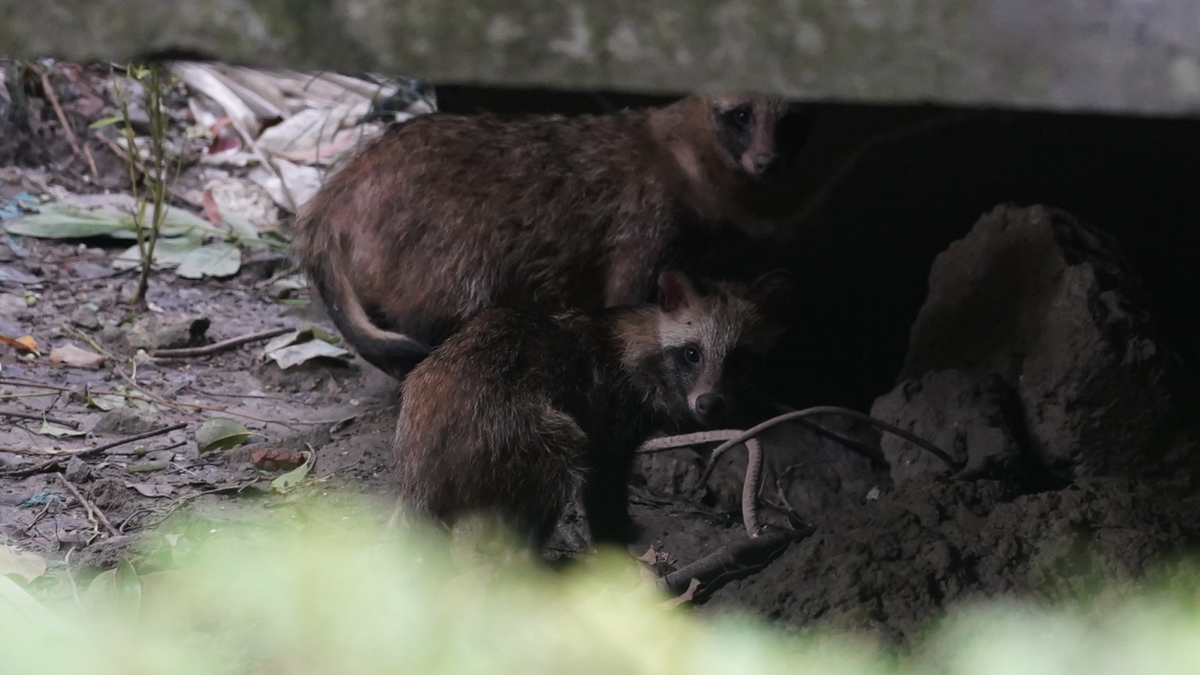 Raccoon dogs are found making home in a residential neighborhood in Songjiang district, Shanghai. [Photo by Gao Erqiang/Chinadaily.com.cn]
Raccoon dogs are found making home in a residential neighborhood in Songjiang district, Shanghai. [Photo by Gao Erqiang/Chinadaily.com.cn]
Earlier this month, people in Wuhan, capital of Hubei province, were surprised to find that raccoon dogs had "invaded" the city.
In fact, the animals can be found not only in Wuhan, but in many cities-where they have always existed-including Shanghai, Nanjing, capital of Jiangsu province, and Hangzhou, capital of Zhejiang province.
Raccoon dogs could once be seen widely in China, but due to diminishing habitat, human activities and the effects of other species, their population in the wild is declining.
The animals have now found a habitat in cities, where they can locate convenient sources of food in domestic waste. They live under buildings and in abandoned sewers.
In the past two years, monitoring work has detected raccoon dogs in more than 150 communities in Shanghai, and we estimate that there are more than 5,000 of them in the city. Their numbers are rising rapidly.
Although at the bottom of the food chain among medium-sized carnivores, the animals have adapted to life in cities, where they dig for worms, hunt rodents, find food in garbage dumps and even catch fish in neighborhood ponds. They are thriving in the human world.
Such changes are the result of the improved urban environment and the way the animals have adjusted to city life.
As city expansion slows, urban ecology is being re-established. Forest parks and wetlands have been restored and "green belts "built alongside roads. These spaces give city residents room to breathe and offer wild animals an urban habitat.
The "urbanization" of some wild animals is a global trend. In Germany, rivers, lakes and green spaces in Berlin have attracted more than 3,000 wild boars. While their appearance has added an element of excitement to the city, the animals have also turned over trash bins and destroyed urban vegetation.
In the United Kingdom, more than 20 red foxes can be found per square kilometer in London. These canine carnivores kill mammals and birds, and they also change soil composition and affect water sources.
In the United States, many families have experienced conflicts with raccoons. Damage to property, along with fires and disease caused by these animals, result in losses of millions of dollars every year.
As city environments continue to improve, raccoon dogs and possibly many other wild animals, such as red-bellied squirrels, chipmunks and boars, will cause problems for urban management in China.
Experience has shown that poisoning and culling cannot control animals that have adapted to city life. Quick fixes will only cause ecological disasters. Finding a way to coexist with these animals is the only option for us.
In Shanghai, raccoon dogs have not attacked people unless they are provoked. Adult raccoon dogs will quickly hide when they encounter humans, but to protect their young, they may fight dogs that are not on a leash.
The raccoon dog population is rising rapidly, as the animals can easily obtain food from leftovers.
Last year, leftovers in one community in Shanghai attracted more than 60 of the animals. The food made them less aware of humans, but also caused them to be more aggressive if approached.
The coexistence of humans and wild animals is an ongoing challenge for urban ecological restoration.
In Shanghai, the authorities continue to explore better solutions. Last year, the municipal wildlife protection authority successfully handled a conflict between raccoon dogs and residents in a community where 50 of the animals were found.
Workers from the authority found that cutting off the animals' food supply was the first step to solving the problem. Within 10 days, the authority issued the first urban wild animal hunting license, captured and safely transported the raccoon dogs to the countryside. It also strictly managed domestic garbage to prevent the animals finding food.
The authority is now drawing up a standardized and comprehensive urban wildlife protection and management plan, with input from the public and a scientific survey.
When researchers, government authorities and volunteers work together, I believe humans and wild animals will have better lives in cities.
Wang Fang was speaking with Xing Yi.

( Wang Fang, researcher at the School of Life Sciences, Fudan University, Shanghai. The views don't necessarily reflect those of these platform.)






